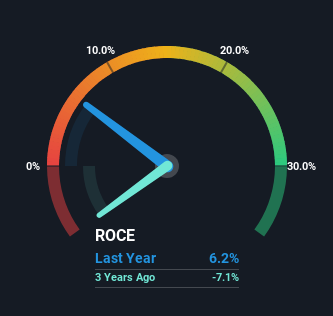- Australia
- /
- Commercial Services
- /
- ASX:NAM
Namoi Cotton (ASX:NAM) Has Some Difficulty Using Its Capital Effectively

To avoid investing in a business that's in decline, there's a few financial metrics that can provide early indications of aging. When we see a declining return on capital employed (ROCE) in conjunction with a declining base of capital employed, that's often how a mature business shows signs of aging. Ultimately this means that the company is earning less per dollar invested and on top of that, it's shrinking its base of capital employed. In light of that, from a first glance at Namoi Cotton (ASX:NAM), we've spotted some signs that it could be struggling, so let's investigate.
Understanding Return On Capital Employed (ROCE)
If you haven't worked with ROCE before, it measures the 'return' (pre-tax profit) a company generates from capital employed in its business. To calculate this metric for Namoi Cotton, this is the formula:
Return on Capital Employed = Earnings Before Interest and Tax (EBIT) ÷ (Total Assets - Current Liabilities)
0.062 = AU$12m ÷ (AU$231m - AU$41m) (Based on the trailing twelve months to August 2023).
Thus, Namoi Cotton has an ROCE of 6.2%. Ultimately, that's a low return and it under-performs the Commercial Services industry average of 7.8%.
See our latest analysis for Namoi Cotton

In the above chart we have measured Namoi Cotton's prior ROCE against its prior performance, but the future is arguably more important. If you'd like, you can check out the forecasts from the analysts covering Namoi Cotton here for free.
What The Trend Of ROCE Can Tell Us
We are a bit worried about the trend of returns on capital at Namoi Cotton. About five years ago, returns on capital were 8.1%, however they're now substantially lower than that as we saw above. And on the capital employed front, the business is utilizing roughly the same amount of capital as it was back then. This combination can be indicative of a mature business that still has areas to deploy capital, but the returns received aren't as high due potentially to new competition or smaller margins. So because these trends aren't typically conducive to creating a multi-bagger, we wouldn't hold our breath on Namoi Cotton becoming one if things continue as they have.
On a side note, Namoi Cotton has done well to pay down its current liabilities to 18% of total assets. So we could link some of this to the decrease in ROCE. Effectively this means their suppliers or short-term creditors are funding less of the business, which reduces some elements of risk. Since the business is basically funding more of its operations with it's own money, you could argue this has made the business less efficient at generating ROCE.
Our Take On Namoi Cotton's ROCE
In summary, it's unfortunate that Namoi Cotton is generating lower returns from the same amount of capital. And, the stock has remained flat over the last five years, so investors don't seem too impressed either. Unless there is a shift to a more positive trajectory in these metrics, we would look elsewhere.
If you want to continue researching Namoi Cotton, you might be interested to know about the 2 warning signs that our analysis has discovered.
For those who like to invest in solid companies, check out this free list of companies with solid balance sheets and high returns on equity.
Valuation is complex, but we're here to simplify it.
Discover if Namoi Cotton might be undervalued or overvalued with our detailed analysis, featuring fair value estimates, potential risks, dividends, insider trades, and its financial condition.
Access Free AnalysisHave feedback on this article? Concerned about the content? Get in touch with us directly. Alternatively, email editorial-team (at) simplywallst.com.
This article by Simply Wall St is general in nature. We provide commentary based on historical data and analyst forecasts only using an unbiased methodology and our articles are not intended to be financial advice. It does not constitute a recommendation to buy or sell any stock, and does not take account of your objectives, or your financial situation. We aim to bring you long-term focused analysis driven by fundamental data. Note that our analysis may not factor in the latest price-sensitive company announcements or qualitative material. Simply Wall St has no position in any stocks mentioned.
About ASX:NAM
Namoi Cotton
Engages in the ginning and supply chain and marketing of cotton in Australia, China, Japan, South Korea, and Thailand.
Solid track record with excellent balance sheet and pays a dividend.
Market Insights
Community Narratives





